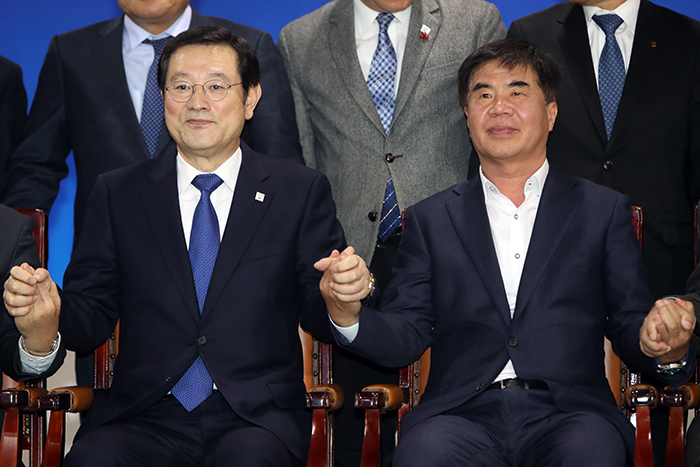-
 Korea.net's 24-hour YouTube channel
Korea.net's 24-hour YouTube channel- NEWS FOCUS
- ABOUT KOREA
- EVENTS
- RESOURCES
- GOVERNMENT
- ABOUT US

Gwangju Mayor Lee Yong-Seop (left) and Federation of Korean Trade Unions President Yoon Jong-hae on Dec. 5 hold hands after concluding their meeting at Gwangju City Hall. (Yonhap News)
By Kim Young Shin
Many countries suffer from a shrinking job market and growing social polarization, and Korea is no exception. To tackle these problems, the Korean government is set to conduct a new experiment, the Gwangju job project by benchmarking two major case studies abroad.
Under the project, workers at the new factory of Hyundai Motor Company in Gwangju are paid half the wages of staff at other automakers but receive welfare benefits from the central and Gwangju municipal governments such as housing, medical care, child care and education. This will boost their real incomes.
Around 12,000 jobs are expected to be created to inject economic vigor into Gwangju and vicinity and encourage domestic companies to keep production at home.
The project was based on two benchmarks from abroad: Volkswagen’s Auto 5000 project in Germany and General Motors’ (GM) Saturn in the U.S.
In 1999, the struggling Volkswagen proposed the Auto 5000 project, under which it would hire 5,000 workers at its new plant for about 80 percent of the regular wages of the carmaker’s regular staff. Though disputes broke out between labor and management over working hours and the payment system, both sides eventually reached an agreement in 2001 through the mediation of the government and experts. Workers hired through this project later earned permanent status in Volkswagen in 2009.
Over in the U.S., GM in 1985 was reeling from heightened competition in the U.S. market from Japanese automakers. The company set up a subsidiary named Saturn with the aim of producing high quality vehicles by revolutionizing the relationship between labor and management. Though offering 90 percent of the average wage at its other assembly plants, the carmaker raised worker productivity and vehicle quality through joint management by the company and its workforce.
“In both cases, labor and management reached an agreement to exchange pay for employment and created a new wage system,” said Park Myung-joon, chief policy specialist of the Economic, Social and Labor Council. “They also utilized innovative factors that improved the manufacturing process and job quality, and these will also be applied to the Gwangju job project.”
“The Gwangju job project is a significant first step that could bridge the wage gap by proposing new mid-level positions,” he said. “It will trigger social communication in other areas to create jobs through collaboration among workers, companies, civilians and the government.”
ysk1111@korea.kr













